Critical Analysis: Social Integration Literature Review
VerifiedAdded on 2023/01/20
|16
|4830
|87
Literature Review
AI Summary
This literature review critically analyzes the concept of social integration, focusing on the historical context of UK migration policies and the debates surrounding them. It examines the evolution from assimilationist models to multiculturalism, exploring the impact of these models on various communities, including the Hazara community. The review delves into the complexities of identity politics, particularly within the Muslim community, and the rise of anti-racism strategies. It further investigates the existence of structural inequality and institutional racism, using examples like the Stephen Lawrence Murder Inquiry and the Swann Report. The analysis highlights issues such as Islamophobia and the challenges faced by ethnic minorities in employment and social mobility, referencing government initiatives like the Social Mobility Commission. The review provides a comprehensive overview of the multifaceted aspects of social integration within the UK context, including the interplay of culture, policy, and societal structures.
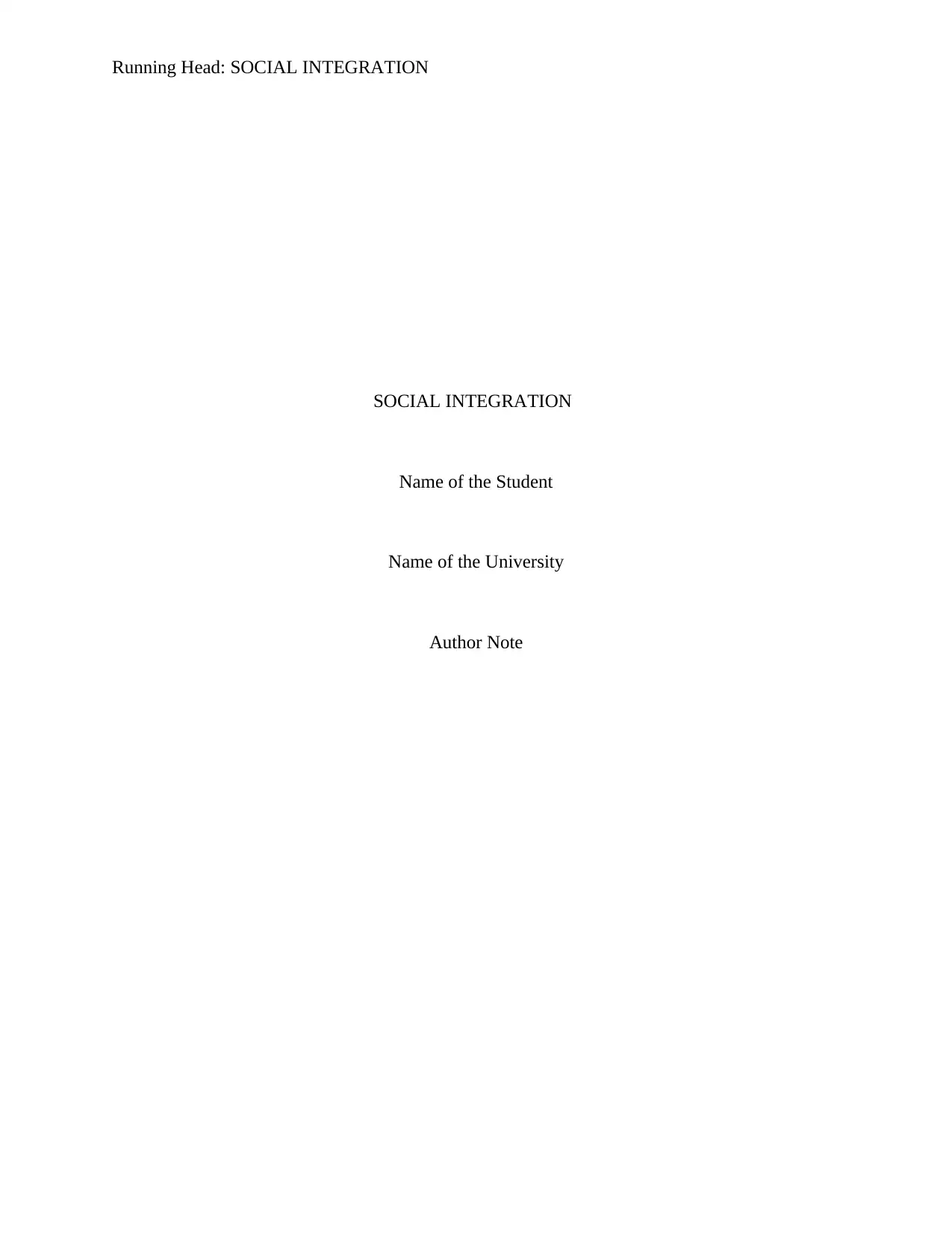
Running Head: SOCIAL INTEGRATION
SOCIAL INTEGRATION
Name of the Student
Name of the University
Author Note
SOCIAL INTEGRATION
Name of the Student
Name of the University
Author Note
Paraphrase This Document
Need a fresh take? Get an instant paraphrase of this document with our AI Paraphraser
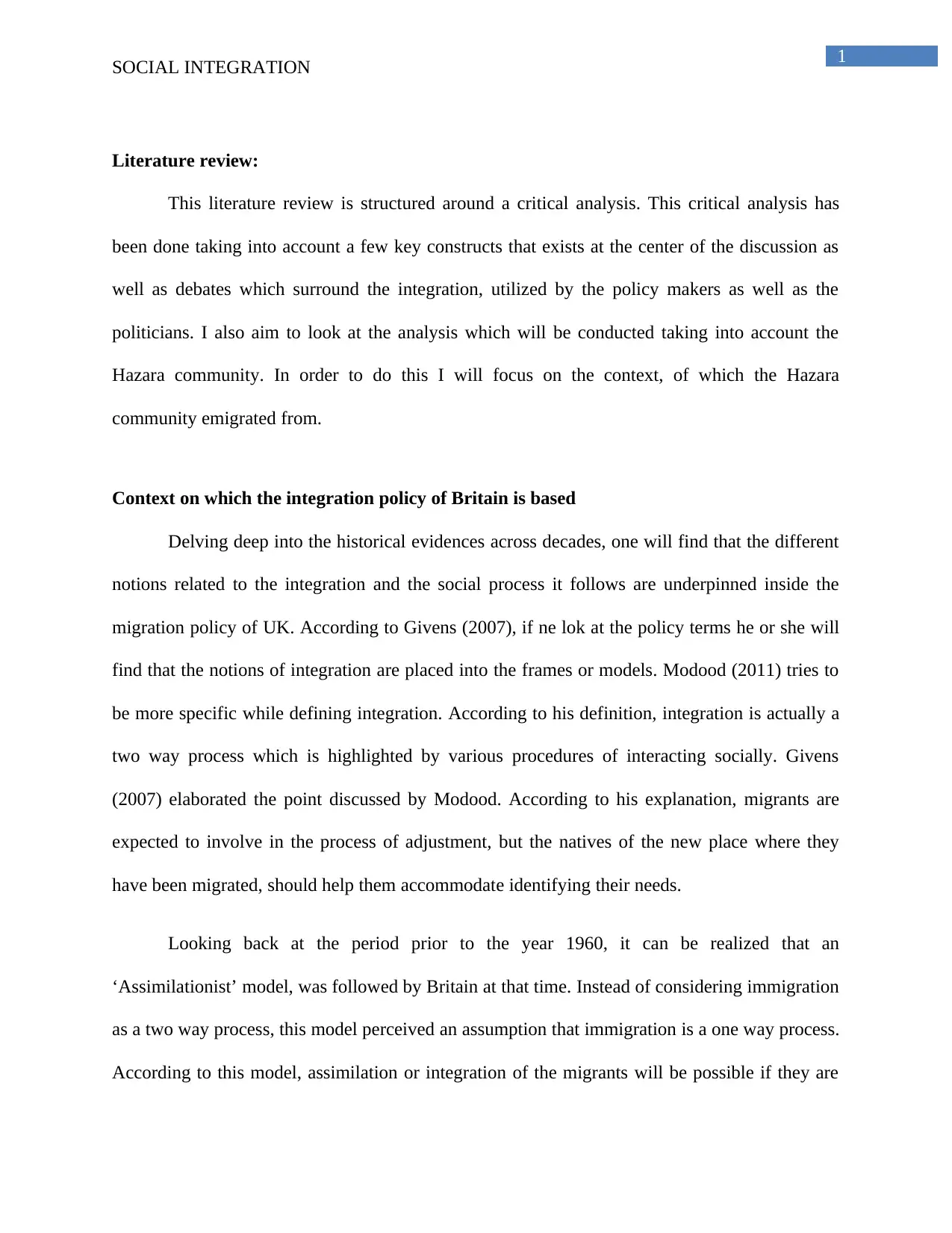
1
SOCIAL INTEGRATION
Literature review:
This literature review is structured around a critical analysis. This critical analysis has
been done taking into account a few key constructs that exists at the center of the discussion as
well as debates which surround the integration, utilized by the policy makers as well as the
politicians. I also aim to look at the analysis which will be conducted taking into account the
Hazara community. In order to do this I will focus on the context, of which the Hazara
community emigrated from.
Context on which the integration policy of Britain is based
Delving deep into the historical evidences across decades, one will find that the different
notions related to the integration and the social process it follows are underpinned inside the
migration policy of UK. According to Givens (2007), if ne lok at the policy terms he or she will
find that the notions of integration are placed into the frames or models. Modood (2011) tries to
be more specific while defining integration. According to his definition, integration is actually a
two way process which is highlighted by various procedures of interacting socially. Givens
(2007) elaborated the point discussed by Modood. According to his explanation, migrants are
expected to involve in the process of adjustment, but the natives of the new place where they
have been migrated, should help them accommodate identifying their needs.
Looking back at the period prior to the year 1960, it can be realized that an
‘Assimilationist’ model, was followed by Britain at that time. Instead of considering immigration
as a two way process, this model perceived an assumption that immigration is a one way process.
According to this model, assimilation or integration of the migrants will be possible if they are
SOCIAL INTEGRATION
Literature review:
This literature review is structured around a critical analysis. This critical analysis has
been done taking into account a few key constructs that exists at the center of the discussion as
well as debates which surround the integration, utilized by the policy makers as well as the
politicians. I also aim to look at the analysis which will be conducted taking into account the
Hazara community. In order to do this I will focus on the context, of which the Hazara
community emigrated from.
Context on which the integration policy of Britain is based
Delving deep into the historical evidences across decades, one will find that the different
notions related to the integration and the social process it follows are underpinned inside the
migration policy of UK. According to Givens (2007), if ne lok at the policy terms he or she will
find that the notions of integration are placed into the frames or models. Modood (2011) tries to
be more specific while defining integration. According to his definition, integration is actually a
two way process which is highlighted by various procedures of interacting socially. Givens
(2007) elaborated the point discussed by Modood. According to his explanation, migrants are
expected to involve in the process of adjustment, but the natives of the new place where they
have been migrated, should help them accommodate identifying their needs.
Looking back at the period prior to the year 1960, it can be realized that an
‘Assimilationist’ model, was followed by Britain at that time. Instead of considering immigration
as a two way process, this model perceived an assumption that immigration is a one way process.
According to this model, assimilation or integration of the migrants will be possible if they are
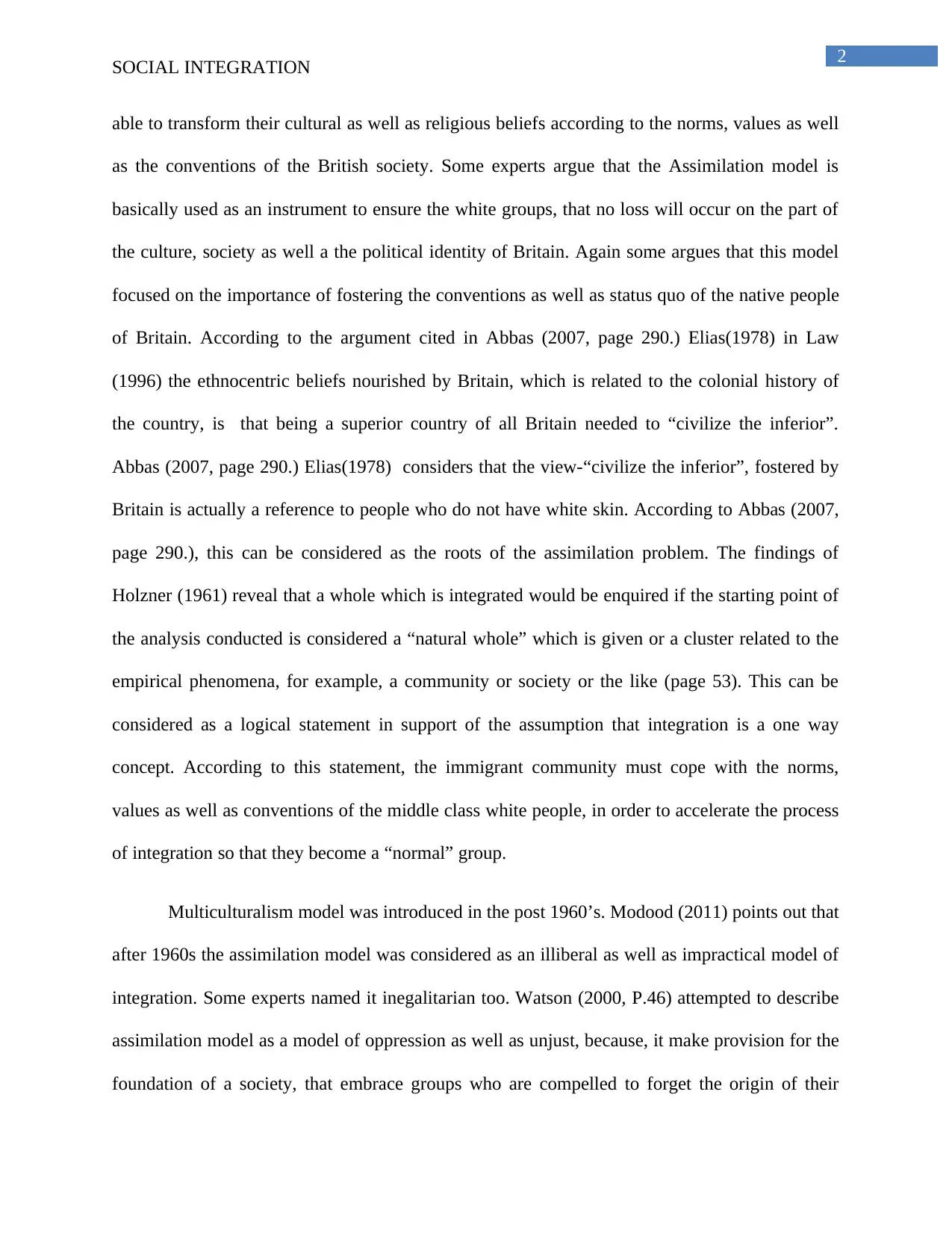
2
SOCIAL INTEGRATION
able to transform their cultural as well as religious beliefs according to the norms, values as well
as the conventions of the British society. Some experts argue that the Assimilation model is
basically used as an instrument to ensure the white groups, that no loss will occur on the part of
the culture, society as well a the political identity of Britain. Again some argues that this model
focused on the importance of fostering the conventions as well as status quo of the native people
of Britain. According to the argument cited in Abbas (2007, page 290.) Elias(1978) in Law
(1996) the ethnocentric beliefs nourished by Britain, which is related to the colonial history of
the country, is that being a superior country of all Britain needed to “civilize the inferior”.
Abbas (2007, page 290.) Elias(1978) considers that the view-“civilize the inferior”, fostered by
Britain is actually a reference to people who do not have white skin. According to Abbas (2007,
page 290.), this can be considered as the roots of the assimilation problem. The findings of
Holzner (1961) reveal that a whole which is integrated would be enquired if the starting point of
the analysis conducted is considered a “natural whole” which is given or a cluster related to the
empirical phenomena, for example, a community or society or the like (page 53). This can be
considered as a logical statement in support of the assumption that integration is a one way
concept. According to this statement, the immigrant community must cope with the norms,
values as well as conventions of the middle class white people, in order to accelerate the process
of integration so that they become a “normal” group.
Multiculturalism model was introduced in the post 1960’s. Modood (2011) points out that
after 1960s the assimilation model was considered as an illiberal as well as impractical model of
integration. Some experts named it inegalitarian too. Watson (2000, P.46) attempted to describe
assimilation model as a model of oppression as well as unjust, because, it make provision for the
foundation of a society, that embrace groups who are compelled to forget the origin of their
SOCIAL INTEGRATION
able to transform their cultural as well as religious beliefs according to the norms, values as well
as the conventions of the British society. Some experts argue that the Assimilation model is
basically used as an instrument to ensure the white groups, that no loss will occur on the part of
the culture, society as well a the political identity of Britain. Again some argues that this model
focused on the importance of fostering the conventions as well as status quo of the native people
of Britain. According to the argument cited in Abbas (2007, page 290.) Elias(1978) in Law
(1996) the ethnocentric beliefs nourished by Britain, which is related to the colonial history of
the country, is that being a superior country of all Britain needed to “civilize the inferior”.
Abbas (2007, page 290.) Elias(1978) considers that the view-“civilize the inferior”, fostered by
Britain is actually a reference to people who do not have white skin. According to Abbas (2007,
page 290.), this can be considered as the roots of the assimilation problem. The findings of
Holzner (1961) reveal that a whole which is integrated would be enquired if the starting point of
the analysis conducted is considered a “natural whole” which is given or a cluster related to the
empirical phenomena, for example, a community or society or the like (page 53). This can be
considered as a logical statement in support of the assumption that integration is a one way
concept. According to this statement, the immigrant community must cope with the norms,
values as well as conventions of the middle class white people, in order to accelerate the process
of integration so that they become a “normal” group.
Multiculturalism model was introduced in the post 1960’s. Modood (2011) points out that
after 1960s the assimilation model was considered as an illiberal as well as impractical model of
integration. Some experts named it inegalitarian too. Watson (2000, P.46) attempted to describe
assimilation model as a model of oppression as well as unjust, because, it make provision for the
foundation of a society, that embrace groups who are compelled to forget the origin of their
⊘ This is a preview!⊘
Do you want full access?
Subscribe today to unlock all pages.

Trusted by 1+ million students worldwide
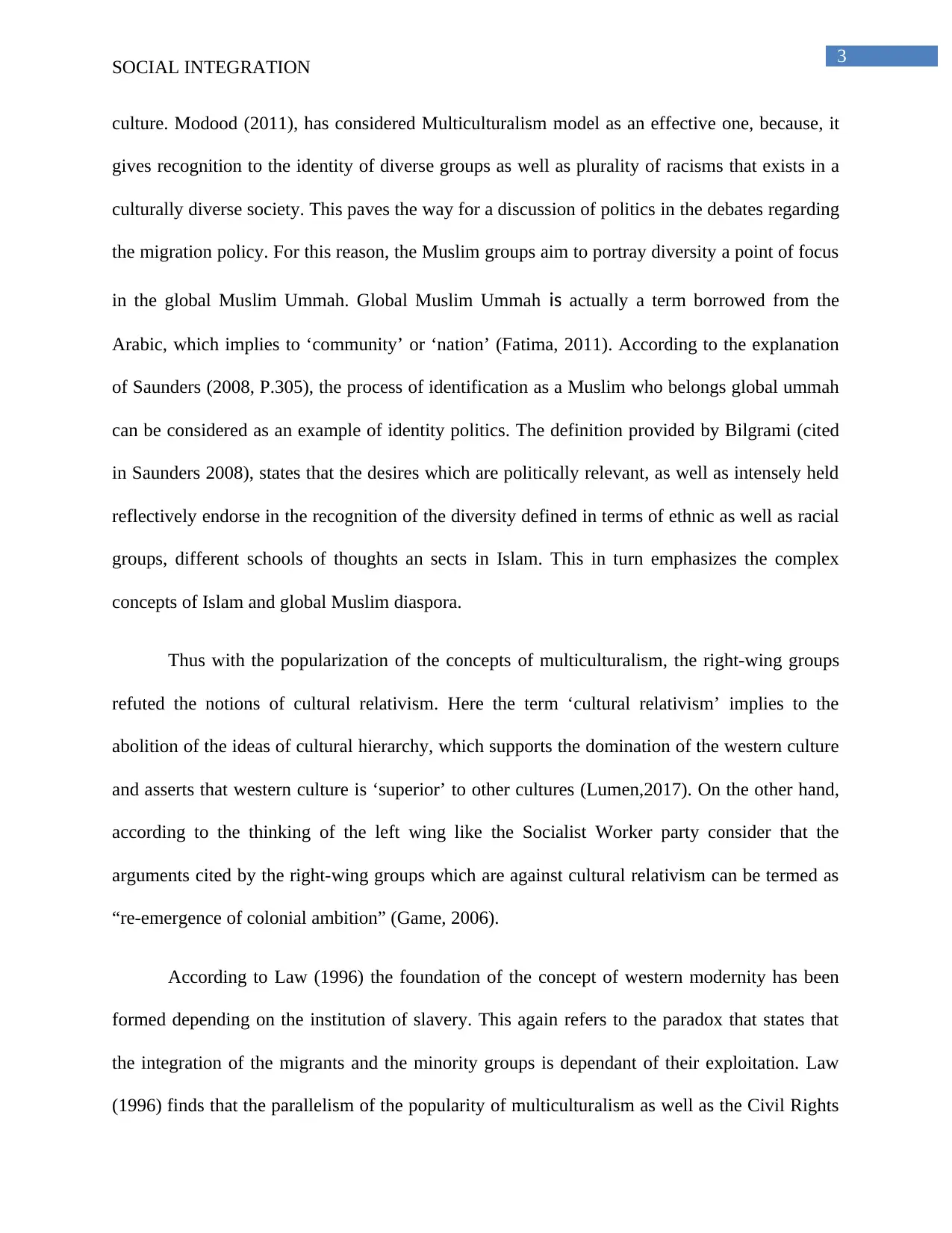
3
SOCIAL INTEGRATION
culture. Modood (2011), has considered Multiculturalism model as an effective one, because, it
gives recognition to the identity of diverse groups as well as plurality of racisms that exists in a
culturally diverse society. This paves the way for a discussion of politics in the debates regarding
the migration policy. For this reason, the Muslim groups aim to portray diversity a point of focus
in the global Muslim Ummah. Global Muslim Ummah is actually a term borrowed from the
Arabic, which implies to ‘community’ or ‘nation’ (Fatima, 2011). According to the explanation
of Saunders (2008, P.305), the process of identification as a Muslim who belongs global ummah
can be considered as an example of identity politics. The definition provided by Bilgrami (cited
in Saunders 2008), states that the desires which are politically relevant, as well as intensely held
reflectively endorse in the recognition of the diversity defined in terms of ethnic as well as racial
groups, different schools of thoughts an sects in Islam. This in turn emphasizes the complex
concepts of Islam and global Muslim diaspora.
Thus with the popularization of the concepts of multiculturalism, the right-wing groups
refuted the notions of cultural relativism. Here the term ‘cultural relativism’ implies to the
abolition of the ideas of cultural hierarchy, which supports the domination of the western culture
and asserts that western culture is ‘superior’ to other cultures (Lumen,2017). On the other hand,
according to the thinking of the left wing like the Socialist Worker party consider that the
arguments cited by the right-wing groups which are against cultural relativism can be termed as
“re-emergence of colonial ambition” (Game, 2006).
According to Law (1996) the foundation of the concept of western modernity has been
formed depending on the institution of slavery. This again refers to the paradox that states that
the integration of the migrants and the minority groups is dependant of their exploitation. Law
(1996) finds that the parallelism of the popularity of multiculturalism as well as the Civil Rights
SOCIAL INTEGRATION
culture. Modood (2011), has considered Multiculturalism model as an effective one, because, it
gives recognition to the identity of diverse groups as well as plurality of racisms that exists in a
culturally diverse society. This paves the way for a discussion of politics in the debates regarding
the migration policy. For this reason, the Muslim groups aim to portray diversity a point of focus
in the global Muslim Ummah. Global Muslim Ummah is actually a term borrowed from the
Arabic, which implies to ‘community’ or ‘nation’ (Fatima, 2011). According to the explanation
of Saunders (2008, P.305), the process of identification as a Muslim who belongs global ummah
can be considered as an example of identity politics. The definition provided by Bilgrami (cited
in Saunders 2008), states that the desires which are politically relevant, as well as intensely held
reflectively endorse in the recognition of the diversity defined in terms of ethnic as well as racial
groups, different schools of thoughts an sects in Islam. This in turn emphasizes the complex
concepts of Islam and global Muslim diaspora.
Thus with the popularization of the concepts of multiculturalism, the right-wing groups
refuted the notions of cultural relativism. Here the term ‘cultural relativism’ implies to the
abolition of the ideas of cultural hierarchy, which supports the domination of the western culture
and asserts that western culture is ‘superior’ to other cultures (Lumen,2017). On the other hand,
according to the thinking of the left wing like the Socialist Worker party consider that the
arguments cited by the right-wing groups which are against cultural relativism can be termed as
“re-emergence of colonial ambition” (Game, 2006).
According to Law (1996) the foundation of the concept of western modernity has been
formed depending on the institution of slavery. This again refers to the paradox that states that
the integration of the migrants and the minority groups is dependant of their exploitation. Law
(1996) finds that the parallelism of the popularity of multiculturalism as well as the Civil Rights
Paraphrase This Document
Need a fresh take? Get an instant paraphrase of this document with our AI Paraphraser
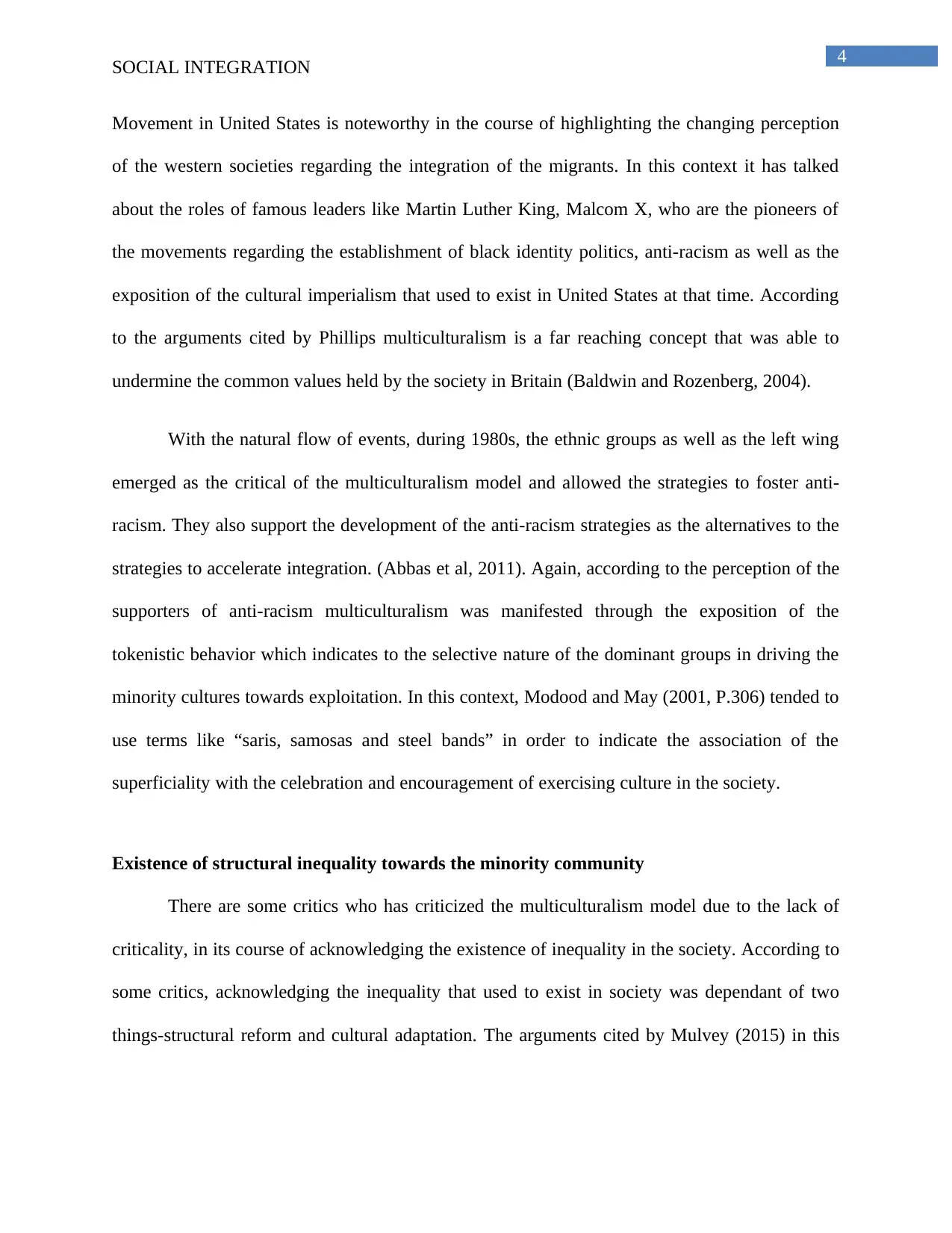
4
SOCIAL INTEGRATION
Movement in United States is noteworthy in the course of highlighting the changing perception
of the western societies regarding the integration of the migrants. In this context it has talked
about the roles of famous leaders like Martin Luther King, Malcom X, who are the pioneers of
the movements regarding the establishment of black identity politics, anti-racism as well as the
exposition of the cultural imperialism that used to exist in United States at that time. According
to the arguments cited by Phillips multiculturalism is a far reaching concept that was able to
undermine the common values held by the society in Britain (Baldwin and Rozenberg, 2004).
With the natural flow of events, during 1980s, the ethnic groups as well as the left wing
emerged as the critical of the multiculturalism model and allowed the strategies to foster anti-
racism. They also support the development of the anti-racism strategies as the alternatives to the
strategies to accelerate integration. (Abbas et al, 2011). Again, according to the perception of the
supporters of anti-racism multiculturalism was manifested through the exposition of the
tokenistic behavior which indicates to the selective nature of the dominant groups in driving the
minority cultures towards exploitation. In this context, Modood and May (2001, P.306) tended to
use terms like “saris, samosas and steel bands” in order to indicate the association of the
superficiality with the celebration and encouragement of exercising culture in the society.
Existence of structural inequality towards the minority community
There are some critics who has criticized the multiculturalism model due to the lack of
criticality, in its course of acknowledging the existence of inequality in the society. According to
some critics, acknowledging the inequality that used to exist in society was dependant of two
things-structural reform and cultural adaptation. The arguments cited by Mulvey (2015) in this
SOCIAL INTEGRATION
Movement in United States is noteworthy in the course of highlighting the changing perception
of the western societies regarding the integration of the migrants. In this context it has talked
about the roles of famous leaders like Martin Luther King, Malcom X, who are the pioneers of
the movements regarding the establishment of black identity politics, anti-racism as well as the
exposition of the cultural imperialism that used to exist in United States at that time. According
to the arguments cited by Phillips multiculturalism is a far reaching concept that was able to
undermine the common values held by the society in Britain (Baldwin and Rozenberg, 2004).
With the natural flow of events, during 1980s, the ethnic groups as well as the left wing
emerged as the critical of the multiculturalism model and allowed the strategies to foster anti-
racism. They also support the development of the anti-racism strategies as the alternatives to the
strategies to accelerate integration. (Abbas et al, 2011). Again, according to the perception of the
supporters of anti-racism multiculturalism was manifested through the exposition of the
tokenistic behavior which indicates to the selective nature of the dominant groups in driving the
minority cultures towards exploitation. In this context, Modood and May (2001, P.306) tended to
use terms like “saris, samosas and steel bands” in order to indicate the association of the
superficiality with the celebration and encouragement of exercising culture in the society.
Existence of structural inequality towards the minority community
There are some critics who has criticized the multiculturalism model due to the lack of
criticality, in its course of acknowledging the existence of inequality in the society. According to
some critics, acknowledging the inequality that used to exist in society was dependant of two
things-structural reform and cultural adaptation. The arguments cited by Mulvey (2015) in this
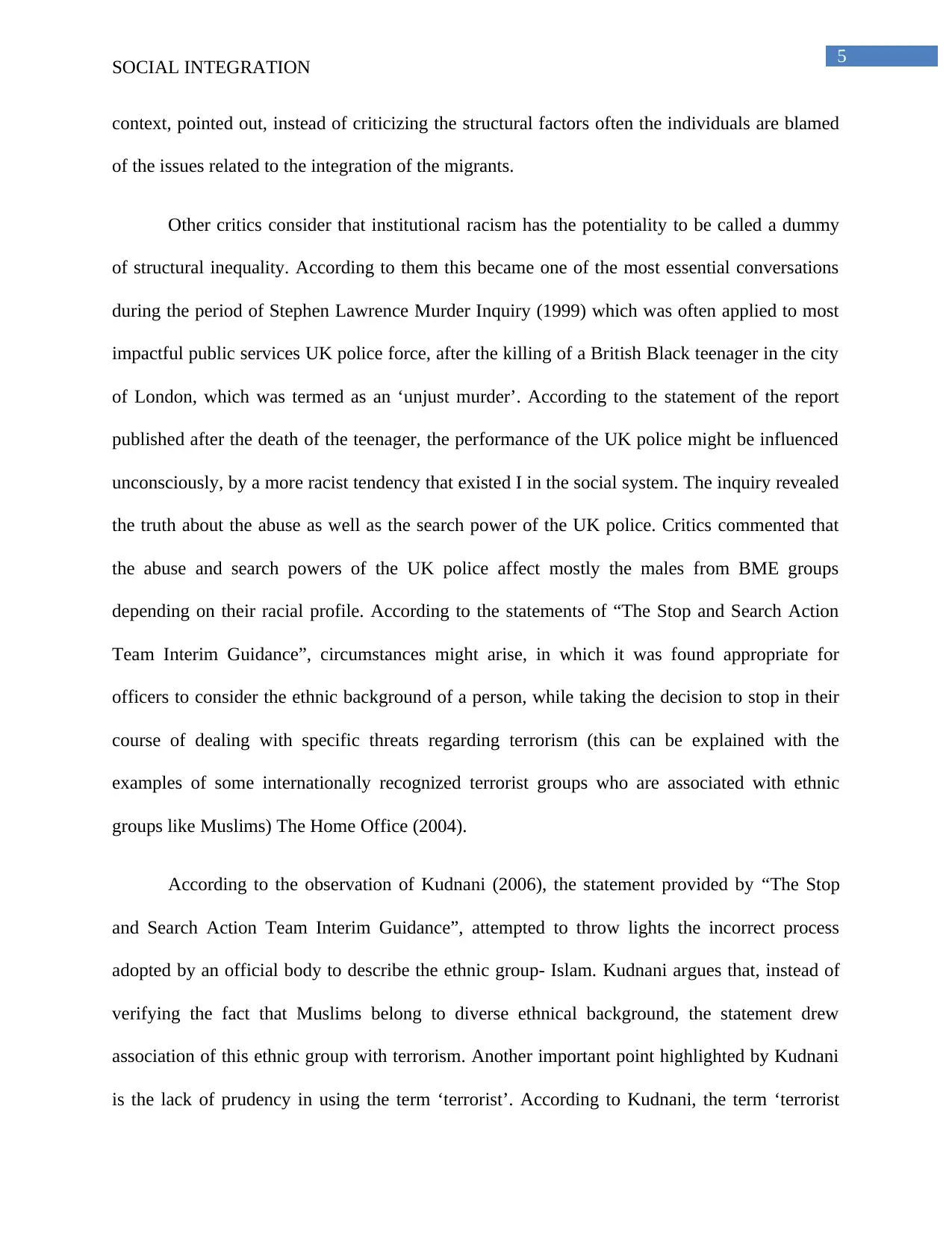
5
SOCIAL INTEGRATION
context, pointed out, instead of criticizing the structural factors often the individuals are blamed
of the issues related to the integration of the migrants.
Other critics consider that institutional racism has the potentiality to be called a dummy
of structural inequality. According to them this became one of the most essential conversations
during the period of Stephen Lawrence Murder Inquiry (1999) which was often applied to most
impactful public services UK police force, after the killing of a British Black teenager in the city
of London, which was termed as an ‘unjust murder’. According to the statement of the report
published after the death of the teenager, the performance of the UK police might be influenced
unconsciously, by a more racist tendency that existed I in the social system. The inquiry revealed
the truth about the abuse as well as the search power of the UK police. Critics commented that
the abuse and search powers of the UK police affect mostly the males from BME groups
depending on their racial profile. According to the statements of “The Stop and Search Action
Team Interim Guidance”, circumstances might arise, in which it was found appropriate for
officers to consider the ethnic background of a person, while taking the decision to stop in their
course of dealing with specific threats regarding terrorism (this can be explained with the
examples of some internationally recognized terrorist groups who are associated with ethnic
groups like Muslims) The Home Office (2004).
According to the observation of Kudnani (2006), the statement provided by “The Stop
and Search Action Team Interim Guidance”, attempted to throw lights the incorrect process
adopted by an official body to describe the ethnic group- Islam. Kudnani argues that, instead of
verifying the fact that Muslims belong to diverse ethnical background, the statement drew
association of this ethnic group with terrorism. Another important point highlighted by Kudnani
is the lack of prudency in using the term ‘terrorist’. According to Kudnani, the term ‘terrorist
SOCIAL INTEGRATION
context, pointed out, instead of criticizing the structural factors often the individuals are blamed
of the issues related to the integration of the migrants.
Other critics consider that institutional racism has the potentiality to be called a dummy
of structural inequality. According to them this became one of the most essential conversations
during the period of Stephen Lawrence Murder Inquiry (1999) which was often applied to most
impactful public services UK police force, after the killing of a British Black teenager in the city
of London, which was termed as an ‘unjust murder’. According to the statement of the report
published after the death of the teenager, the performance of the UK police might be influenced
unconsciously, by a more racist tendency that existed I in the social system. The inquiry revealed
the truth about the abuse as well as the search power of the UK police. Critics commented that
the abuse and search powers of the UK police affect mostly the males from BME groups
depending on their racial profile. According to the statements of “The Stop and Search Action
Team Interim Guidance”, circumstances might arise, in which it was found appropriate for
officers to consider the ethnic background of a person, while taking the decision to stop in their
course of dealing with specific threats regarding terrorism (this can be explained with the
examples of some internationally recognized terrorist groups who are associated with ethnic
groups like Muslims) The Home Office (2004).
According to the observation of Kudnani (2006), the statement provided by “The Stop
and Search Action Team Interim Guidance”, attempted to throw lights the incorrect process
adopted by an official body to describe the ethnic group- Islam. Kudnani argues that, instead of
verifying the fact that Muslims belong to diverse ethnical background, the statement drew
association of this ethnic group with terrorism. Another important point highlighted by Kudnani
is the lack of prudency in using the term ‘terrorist’. According to Kudnani, the term ‘terrorist
⊘ This is a preview!⊘
Do you want full access?
Subscribe today to unlock all pages.

Trusted by 1+ million students worldwide
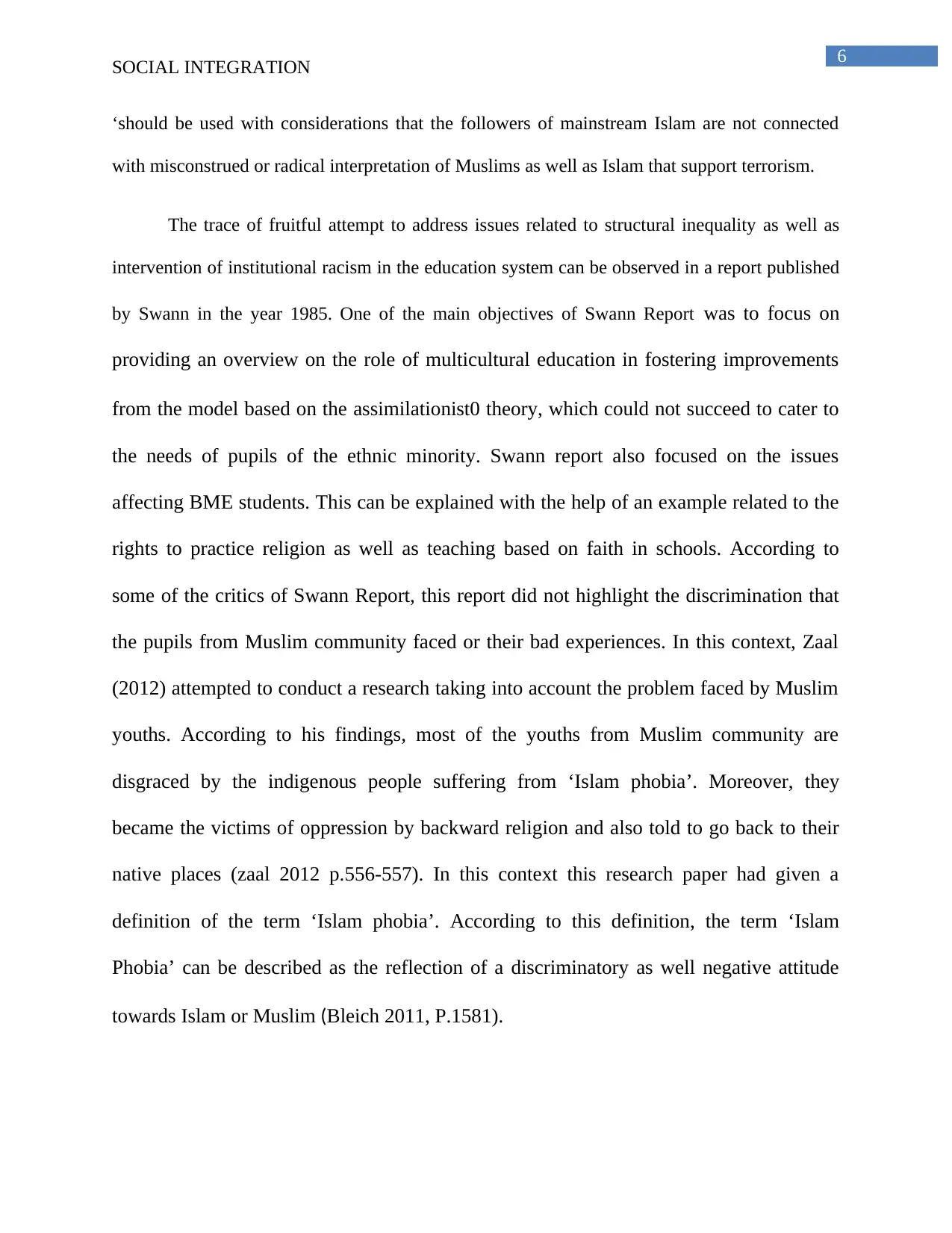
6
SOCIAL INTEGRATION
‘should be used with considerations that the followers of mainstream Islam are not connected
with misconstrued or radical interpretation of Muslims as well as Islam that support terrorism.
The trace of fruitful attempt to address issues related to structural inequality as well as
intervention of institutional racism in the education system can be observed in a report published
by Swann in the year 1985. One of the main objectives of Swann Report was to focus on
providing an overview on the role of multicultural education in fostering improvements
from the model based on the assimilationist0 theory, which could not succeed to cater to
the needs of pupils of the ethnic minority. Swann report also focused on the issues
affecting BME students. This can be explained with the help of an example related to the
rights to practice religion as well as teaching based on faith in schools. According to
some of the critics of Swann Report, this report did not highlight the discrimination that
the pupils from Muslim community faced or their bad experiences. In this context, Zaal
(2012) attempted to conduct a research taking into account the problem faced by Muslim
youths. According to his findings, most of the youths from Muslim community are
disgraced by the indigenous people suffering from ‘Islam phobia’. Moreover, they
became the victims of oppression by backward religion and also told to go back to their
native places (zaal 2012 p.556-557). In this context this research paper had given a
definition of the term ‘Islam phobia’. According to this definition, the term ‘Islam
Phobia’ can be described as the reflection of a discriminatory as well negative attitude
towards Islam or Muslim (Bleich 2011, P.1581).
SOCIAL INTEGRATION
‘should be used with considerations that the followers of mainstream Islam are not connected
with misconstrued or radical interpretation of Muslims as well as Islam that support terrorism.
The trace of fruitful attempt to address issues related to structural inequality as well as
intervention of institutional racism in the education system can be observed in a report published
by Swann in the year 1985. One of the main objectives of Swann Report was to focus on
providing an overview on the role of multicultural education in fostering improvements
from the model based on the assimilationist0 theory, which could not succeed to cater to
the needs of pupils of the ethnic minority. Swann report also focused on the issues
affecting BME students. This can be explained with the help of an example related to the
rights to practice religion as well as teaching based on faith in schools. According to
some of the critics of Swann Report, this report did not highlight the discrimination that
the pupils from Muslim community faced or their bad experiences. In this context, Zaal
(2012) attempted to conduct a research taking into account the problem faced by Muslim
youths. According to his findings, most of the youths from Muslim community are
disgraced by the indigenous people suffering from ‘Islam phobia’. Moreover, they
became the victims of oppression by backward religion and also told to go back to their
native places (zaal 2012 p.556-557). In this context this research paper had given a
definition of the term ‘Islam phobia’. According to this definition, the term ‘Islam
Phobia’ can be described as the reflection of a discriminatory as well negative attitude
towards Islam or Muslim (Bleich 2011, P.1581).
Paraphrase This Document
Need a fresh take? Get an instant paraphrase of this document with our AI Paraphraser
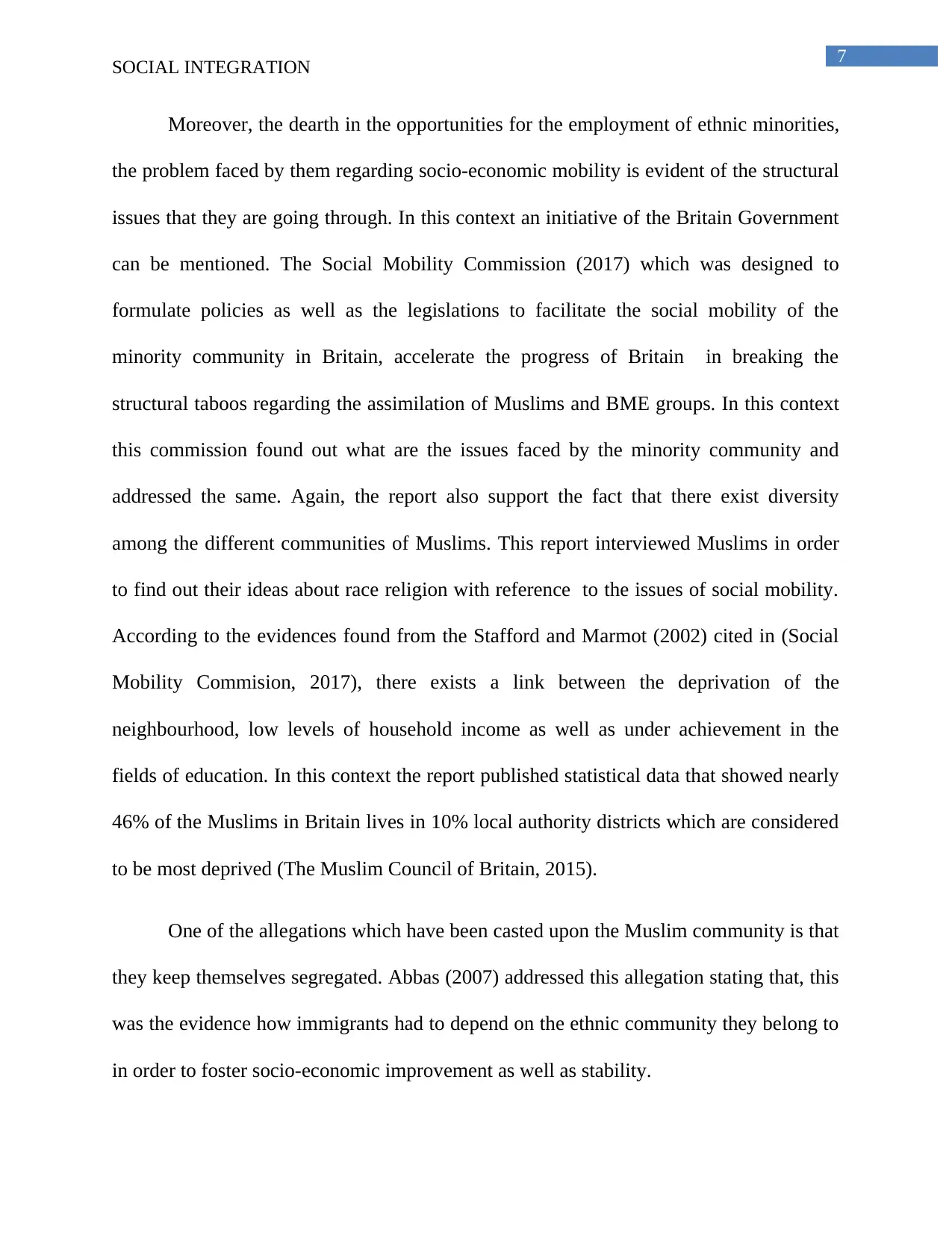
7
SOCIAL INTEGRATION
Moreover, the dearth in the opportunities for the employment of ethnic minorities,
the problem faced by them regarding socio-economic mobility is evident of the structural
issues that they are going through. In this context an initiative of the Britain Government
can be mentioned. The Social Mobility Commission (2017) which was designed to
formulate policies as well as the legislations to facilitate the social mobility of the
minority community in Britain, accelerate the progress of Britain in breaking the
structural taboos regarding the assimilation of Muslims and BME groups. In this context
this commission found out what are the issues faced by the minority community and
addressed the same. Again, the report also support the fact that there exist diversity
among the different communities of Muslims. This report interviewed Muslims in order
to find out their ideas about race religion with reference to the issues of social mobility.
According to the evidences found from the Stafford and Marmot (2002) cited in (Social
Mobility Commision, 2017), there exists a link between the deprivation of the
neighbourhood, low levels of household income as well as under achievement in the
fields of education. In this context the report published statistical data that showed nearly
46% of the Muslims in Britain lives in 10% local authority districts which are considered
to be most deprived (The Muslim Council of Britain, 2015).
One of the allegations which have been casted upon the Muslim community is that
they keep themselves segregated. Abbas (2007) addressed this allegation stating that, this
was the evidence how immigrants had to depend on the ethnic community they belong to
in order to foster socio-economic improvement as well as stability.
SOCIAL INTEGRATION
Moreover, the dearth in the opportunities for the employment of ethnic minorities,
the problem faced by them regarding socio-economic mobility is evident of the structural
issues that they are going through. In this context an initiative of the Britain Government
can be mentioned. The Social Mobility Commission (2017) which was designed to
formulate policies as well as the legislations to facilitate the social mobility of the
minority community in Britain, accelerate the progress of Britain in breaking the
structural taboos regarding the assimilation of Muslims and BME groups. In this context
this commission found out what are the issues faced by the minority community and
addressed the same. Again, the report also support the fact that there exist diversity
among the different communities of Muslims. This report interviewed Muslims in order
to find out their ideas about race religion with reference to the issues of social mobility.
According to the evidences found from the Stafford and Marmot (2002) cited in (Social
Mobility Commision, 2017), there exists a link between the deprivation of the
neighbourhood, low levels of household income as well as under achievement in the
fields of education. In this context the report published statistical data that showed nearly
46% of the Muslims in Britain lives in 10% local authority districts which are considered
to be most deprived (The Muslim Council of Britain, 2015).
One of the allegations which have been casted upon the Muslim community is that
they keep themselves segregated. Abbas (2007) addressed this allegation stating that, this
was the evidence how immigrants had to depend on the ethnic community they belong to
in order to foster socio-economic improvement as well as stability.
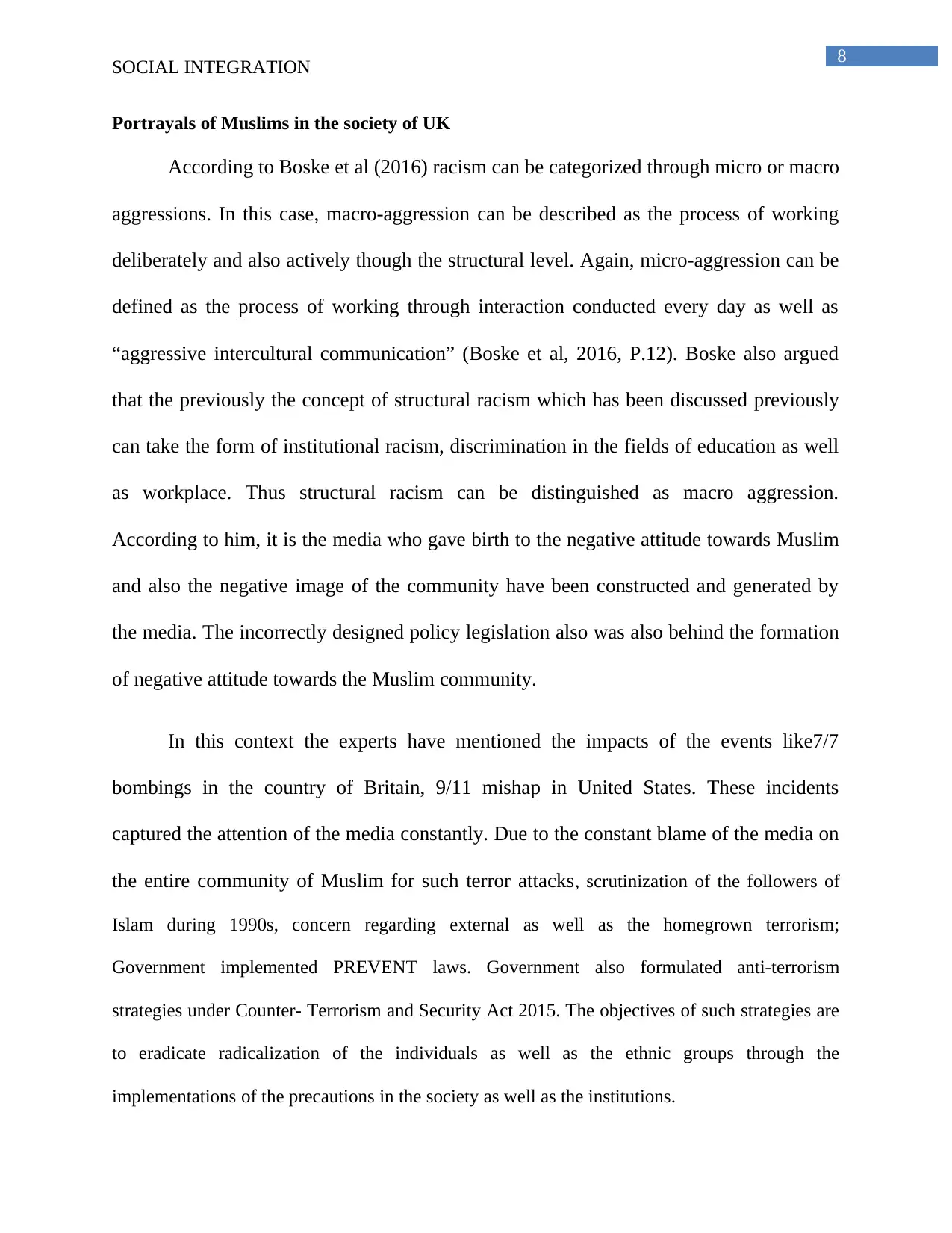
8
SOCIAL INTEGRATION
Portrayals of Muslims in the society of UK
According to Boske et al (2016) racism can be categorized through micro or macro
aggressions. In this case, macro-aggression can be described as the process of working
deliberately and also actively though the structural level. Again, micro-aggression can be
defined as the process of working through interaction conducted every day as well as
“aggressive intercultural communication” (Boske et al, 2016, P.12). Boske also argued
that the previously the concept of structural racism which has been discussed previously
can take the form of institutional racism, discrimination in the fields of education as well
as workplace. Thus structural racism can be distinguished as macro aggression.
According to him, it is the media who gave birth to the negative attitude towards Muslim
and also the negative image of the community have been constructed and generated by
the media. The incorrectly designed policy legislation also was also behind the formation
of negative attitude towards the Muslim community.
In this context the experts have mentioned the impacts of the events like7/7
bombings in the country of Britain, 9/11 mishap in United States. These incidents
captured the attention of the media constantly. Due to the constant blame of the media on
the entire community of Muslim for such terror attacks, scrutinization of the followers of
Islam during 1990s, concern regarding external as well as the homegrown terrorism;
Government implemented PREVENT laws. Government also formulated anti-terrorism
strategies under Counter- Terrorism and Security Act 2015. The objectives of such strategies are
to eradicate radicalization of the individuals as well as the ethnic groups through the
implementations of the precautions in the society as well as the institutions.
SOCIAL INTEGRATION
Portrayals of Muslims in the society of UK
According to Boske et al (2016) racism can be categorized through micro or macro
aggressions. In this case, macro-aggression can be described as the process of working
deliberately and also actively though the structural level. Again, micro-aggression can be
defined as the process of working through interaction conducted every day as well as
“aggressive intercultural communication” (Boske et al, 2016, P.12). Boske also argued
that the previously the concept of structural racism which has been discussed previously
can take the form of institutional racism, discrimination in the fields of education as well
as workplace. Thus structural racism can be distinguished as macro aggression.
According to him, it is the media who gave birth to the negative attitude towards Muslim
and also the negative image of the community have been constructed and generated by
the media. The incorrectly designed policy legislation also was also behind the formation
of negative attitude towards the Muslim community.
In this context the experts have mentioned the impacts of the events like7/7
bombings in the country of Britain, 9/11 mishap in United States. These incidents
captured the attention of the media constantly. Due to the constant blame of the media on
the entire community of Muslim for such terror attacks, scrutinization of the followers of
Islam during 1990s, concern regarding external as well as the homegrown terrorism;
Government implemented PREVENT laws. Government also formulated anti-terrorism
strategies under Counter- Terrorism and Security Act 2015. The objectives of such strategies are
to eradicate radicalization of the individuals as well as the ethnic groups through the
implementations of the precautions in the society as well as the institutions.
⊘ This is a preview!⊘
Do you want full access?
Subscribe today to unlock all pages.

Trusted by 1+ million students worldwide
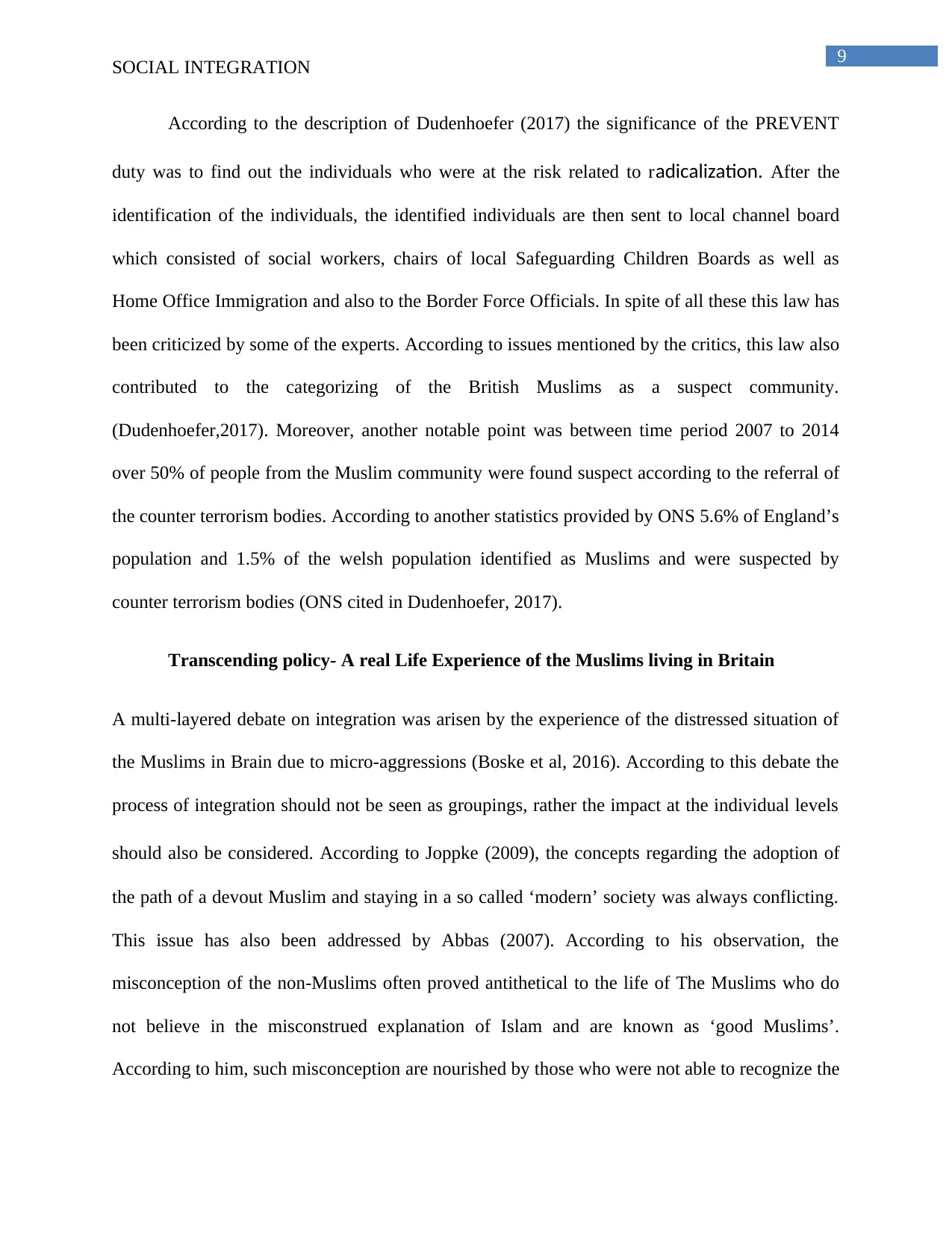
9
SOCIAL INTEGRATION
According to the description of Dudenhoefer (2017) the significance of the PREVENT
duty was to find out the individuals who were at the risk related to radicalization. After the
identification of the individuals, the identified individuals are then sent to local channel board
which consisted of social workers, chairs of local Safeguarding Children Boards as well as
Home Office Immigration and also to the Border Force Officials. In spite of all these this law has
been criticized by some of the experts. According to issues mentioned by the critics, this law also
contributed to the categorizing of the British Muslims as a suspect community.
(Dudenhoefer,2017). Moreover, another notable point was between time period 2007 to 2014
over 50% of people from the Muslim community were found suspect according to the referral of
the counter terrorism bodies. According to another statistics provided by ONS 5.6% of England’s
population and 1.5% of the welsh population identified as Muslims and were suspected by
counter terrorism bodies (ONS cited in Dudenhoefer, 2017).
Transcending policy- A real Life Experience of the Muslims living in Britain
A multi-layered debate on integration was arisen by the experience of the distressed situation of
the Muslims in Brain due to micro-aggressions (Boske et al, 2016). According to this debate the
process of integration should not be seen as groupings, rather the impact at the individual levels
should also be considered. According to Joppke (2009), the concepts regarding the adoption of
the path of a devout Muslim and staying in a so called ‘modern’ society was always conflicting.
This issue has also been addressed by Abbas (2007). According to his observation, the
misconception of the non-Muslims often proved antithetical to the life of The Muslims who do
not believe in the misconstrued explanation of Islam and are known as ‘good Muslims’.
According to him, such misconception are nourished by those who were not able to recognize the
SOCIAL INTEGRATION
According to the description of Dudenhoefer (2017) the significance of the PREVENT
duty was to find out the individuals who were at the risk related to radicalization. After the
identification of the individuals, the identified individuals are then sent to local channel board
which consisted of social workers, chairs of local Safeguarding Children Boards as well as
Home Office Immigration and also to the Border Force Officials. In spite of all these this law has
been criticized by some of the experts. According to issues mentioned by the critics, this law also
contributed to the categorizing of the British Muslims as a suspect community.
(Dudenhoefer,2017). Moreover, another notable point was between time period 2007 to 2014
over 50% of people from the Muslim community were found suspect according to the referral of
the counter terrorism bodies. According to another statistics provided by ONS 5.6% of England’s
population and 1.5% of the welsh population identified as Muslims and were suspected by
counter terrorism bodies (ONS cited in Dudenhoefer, 2017).
Transcending policy- A real Life Experience of the Muslims living in Britain
A multi-layered debate on integration was arisen by the experience of the distressed situation of
the Muslims in Brain due to micro-aggressions (Boske et al, 2016). According to this debate the
process of integration should not be seen as groupings, rather the impact at the individual levels
should also be considered. According to Joppke (2009), the concepts regarding the adoption of
the path of a devout Muslim and staying in a so called ‘modern’ society was always conflicting.
This issue has also been addressed by Abbas (2007). According to his observation, the
misconception of the non-Muslims often proved antithetical to the life of The Muslims who do
not believe in the misconstrued explanation of Islam and are known as ‘good Muslims’.
According to him, such misconception are nourished by those who were not able to recognize the
Paraphrase This Document
Need a fresh take? Get an instant paraphrase of this document with our AI Paraphraser
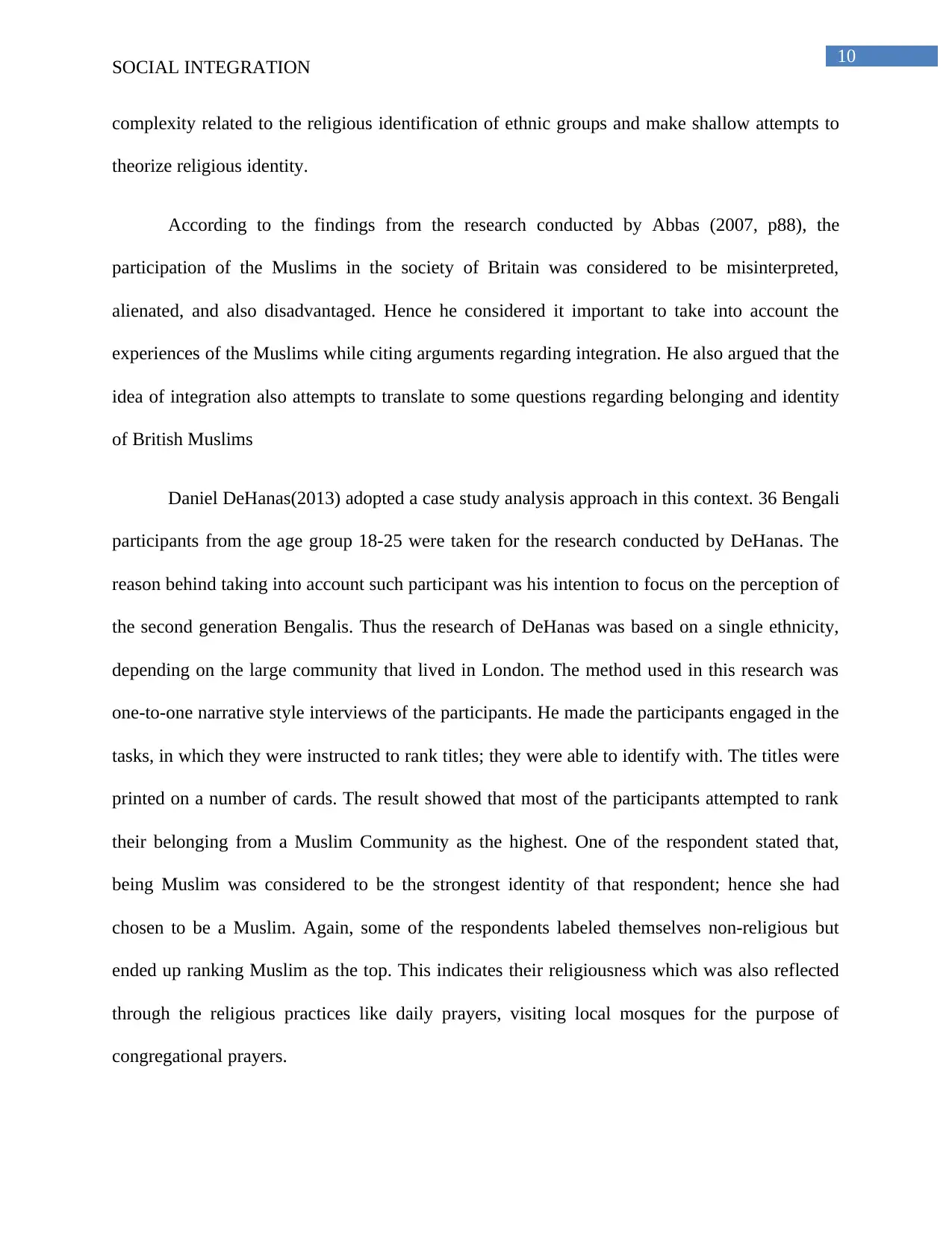
10
SOCIAL INTEGRATION
complexity related to the religious identification of ethnic groups and make shallow attempts to
theorize religious identity.
According to the findings from the research conducted by Abbas (2007, p88), the
participation of the Muslims in the society of Britain was considered to be misinterpreted,
alienated, and also disadvantaged. Hence he considered it important to take into account the
experiences of the Muslims while citing arguments regarding integration. He also argued that the
idea of integration also attempts to translate to some questions regarding belonging and identity
of British Muslims
Daniel DeHanas(2013) adopted a case study analysis approach in this context. 36 Bengali
participants from the age group 18-25 were taken for the research conducted by DeHanas. The
reason behind taking into account such participant was his intention to focus on the perception of
the second generation Bengalis. Thus the research of DeHanas was based on a single ethnicity,
depending on the large community that lived in London. The method used in this research was
one-to-one narrative style interviews of the participants. He made the participants engaged in the
tasks, in which they were instructed to rank titles; they were able to identify with. The titles were
printed on a number of cards. The result showed that most of the participants attempted to rank
their belonging from a Muslim Community as the highest. One of the respondent stated that,
being Muslim was considered to be the strongest identity of that respondent; hence she had
chosen to be a Muslim. Again, some of the respondents labeled themselves non-religious but
ended up ranking Muslim as the top. This indicates their religiousness which was also reflected
through the religious practices like daily prayers, visiting local mosques for the purpose of
congregational prayers.
SOCIAL INTEGRATION
complexity related to the religious identification of ethnic groups and make shallow attempts to
theorize religious identity.
According to the findings from the research conducted by Abbas (2007, p88), the
participation of the Muslims in the society of Britain was considered to be misinterpreted,
alienated, and also disadvantaged. Hence he considered it important to take into account the
experiences of the Muslims while citing arguments regarding integration. He also argued that the
idea of integration also attempts to translate to some questions regarding belonging and identity
of British Muslims
Daniel DeHanas(2013) adopted a case study analysis approach in this context. 36 Bengali
participants from the age group 18-25 were taken for the research conducted by DeHanas. The
reason behind taking into account such participant was his intention to focus on the perception of
the second generation Bengalis. Thus the research of DeHanas was based on a single ethnicity,
depending on the large community that lived in London. The method used in this research was
one-to-one narrative style interviews of the participants. He made the participants engaged in the
tasks, in which they were instructed to rank titles; they were able to identify with. The titles were
printed on a number of cards. The result showed that most of the participants attempted to rank
their belonging from a Muslim Community as the highest. One of the respondent stated that,
being Muslim was considered to be the strongest identity of that respondent; hence she had
chosen to be a Muslim. Again, some of the respondents labeled themselves non-religious but
ended up ranking Muslim as the top. This indicates their religiousness which was also reflected
through the religious practices like daily prayers, visiting local mosques for the purpose of
congregational prayers.
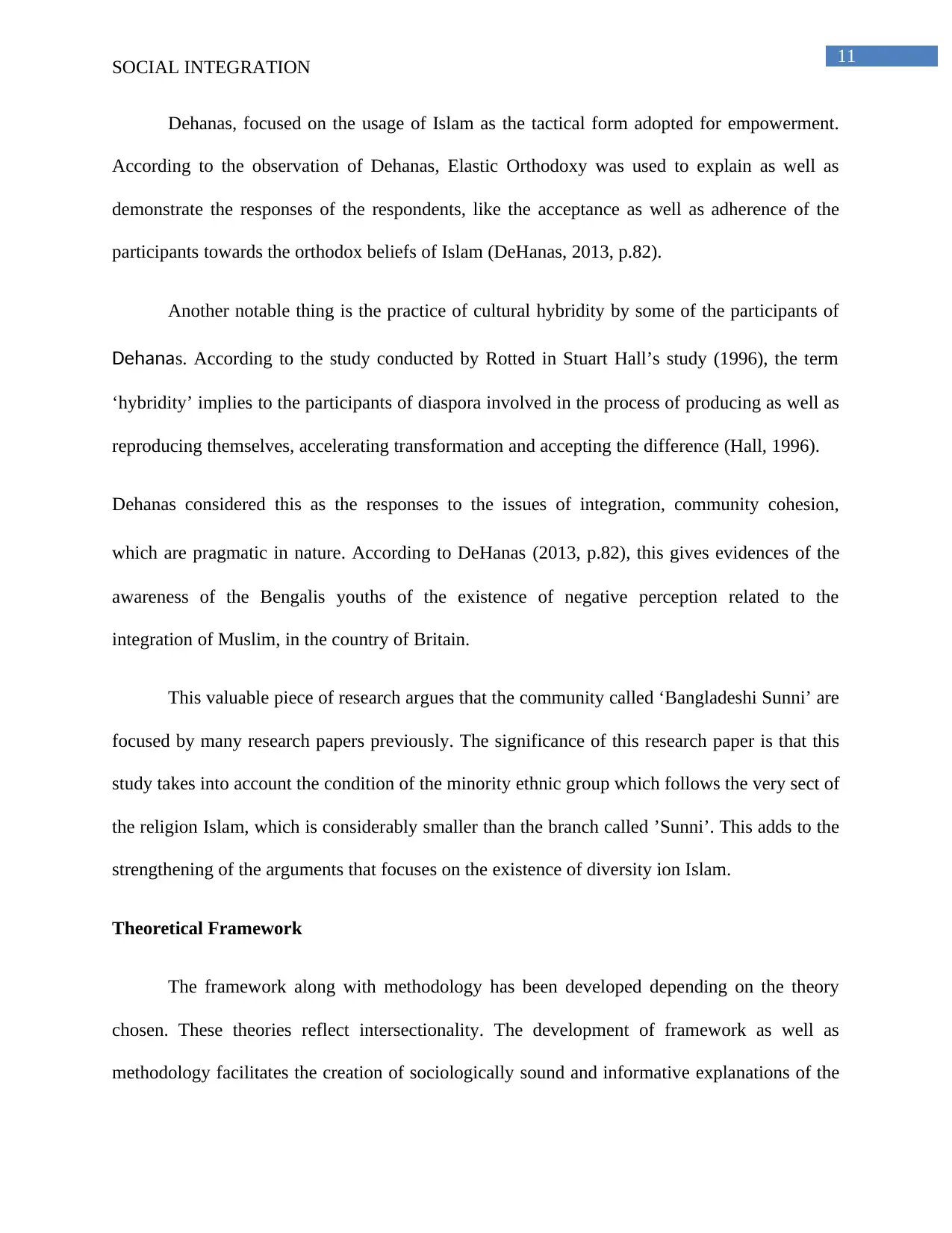
11
SOCIAL INTEGRATION
Dehanas, focused on the usage of Islam as the tactical form adopted for empowerment.
According to the observation of Dehanas, Elastic Orthodoxy was used to explain as well as
demonstrate the responses of the respondents, like the acceptance as well as adherence of the
participants towards the orthodox beliefs of Islam (DeHanas, 2013, p.82).
Another notable thing is the practice of cultural hybridity by some of the participants of
Dehanas. According to the study conducted by Rotted in Stuart Hall’s study (1996), the term
‘hybridity’ implies to the participants of diaspora involved in the process of producing as well as
reproducing themselves, accelerating transformation and accepting the difference (Hall, 1996).
Dehanas considered this as the responses to the issues of integration, community cohesion,
which are pragmatic in nature. According to DeHanas (2013, p.82), this gives evidences of the
awareness of the Bengalis youths of the existence of negative perception related to the
integration of Muslim, in the country of Britain.
This valuable piece of research argues that the community called ‘Bangladeshi Sunni’ are
focused by many research papers previously. The significance of this research paper is that this
study takes into account the condition of the minority ethnic group which follows the very sect of
the religion Islam, which is considerably smaller than the branch called ’Sunni’. This adds to the
strengthening of the arguments that focuses on the existence of diversity ion Islam.
Theoretical Framework
The framework along with methodology has been developed depending on the theory
chosen. These theories reflect intersectionality. The development of framework as well as
methodology facilitates the creation of sociologically sound and informative explanations of the
SOCIAL INTEGRATION
Dehanas, focused on the usage of Islam as the tactical form adopted for empowerment.
According to the observation of Dehanas, Elastic Orthodoxy was used to explain as well as
demonstrate the responses of the respondents, like the acceptance as well as adherence of the
participants towards the orthodox beliefs of Islam (DeHanas, 2013, p.82).
Another notable thing is the practice of cultural hybridity by some of the participants of
Dehanas. According to the study conducted by Rotted in Stuart Hall’s study (1996), the term
‘hybridity’ implies to the participants of diaspora involved in the process of producing as well as
reproducing themselves, accelerating transformation and accepting the difference (Hall, 1996).
Dehanas considered this as the responses to the issues of integration, community cohesion,
which are pragmatic in nature. According to DeHanas (2013, p.82), this gives evidences of the
awareness of the Bengalis youths of the existence of negative perception related to the
integration of Muslim, in the country of Britain.
This valuable piece of research argues that the community called ‘Bangladeshi Sunni’ are
focused by many research papers previously. The significance of this research paper is that this
study takes into account the condition of the minority ethnic group which follows the very sect of
the religion Islam, which is considerably smaller than the branch called ’Sunni’. This adds to the
strengthening of the arguments that focuses on the existence of diversity ion Islam.
Theoretical Framework
The framework along with methodology has been developed depending on the theory
chosen. These theories reflect intersectionality. The development of framework as well as
methodology facilitates the creation of sociologically sound and informative explanations of the
⊘ This is a preview!⊘
Do you want full access?
Subscribe today to unlock all pages.

Trusted by 1+ million students worldwide
1 out of 16
Your All-in-One AI-Powered Toolkit for Academic Success.
+13062052269
info@desklib.com
Available 24*7 on WhatsApp / Email
![[object Object]](/_next/static/media/star-bottom.7253800d.svg)
Unlock your academic potential
Copyright © 2020–2025 A2Z Services. All Rights Reserved. Developed and managed by ZUCOL.